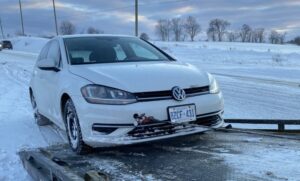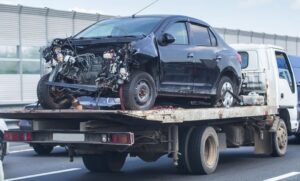The allure of a DIY project can be strong, especially when it promises to save money and solve a common problem. For many tech-savvy individuals, the idea of “making a Car Jump Starter PowerBank” by combining high-capacity lithium batteries with jumper cables might seem like a brilliant, cost-effective solution to roadside emergencies. The concept leverages the widespread availability of powerful battery cells and the desire for self-sufficiency.
However, when it comes to a device designed to deliver hundreds, sometimes thousands, of amps in an instant – enough to crank a cold engine – the line between DIY ingenuity and extreme danger is razor-thin. At Pars Towing, serving the Aurora area and all of Ontario, we frequently assist drivers with dead batteries and understand the critical safety aspects of jump-starting. This comprehensive article will delve into the components and theory behind a Car Jump Starter PowerBank, meticulously outline the severe risks associated with DIY construction, discuss the stringent safety features of commercial units, and ultimately argue why, for the vast majority of drivers, investing in a professionally manufactured unit or calling a trusted service like Pars Towing is the only responsible choice.
- Learn More >>>>Car Battery Booster
Making a Car Jump Starter PowerBank: The DIY Dream vs. Professional Reality in Ontario
1. The Lure of the DIY Car Jump Starter PowerBank: Understanding the Components
A commercial Car Jump Starter PowerBank is essentially a highly engineered battery pack designed for a very specific, high-power discharge. The DIY enthusiast often aims to replicate this using readily available components.
1.1. Core Components (DIY Perspective)
- Lithium Battery Cells: The heart of any modern jump starter. DIY builders typically consider high-drain 18650, 21700, or larger prismatic lithium-ion cells (often LiFePO4 for better safety and lifespan). These are bought individually or in packs.
- Battery Management System (BMS): A crucial electronic circuit board designed to protect the lithium battery pack. It monitors individual cell voltages, temperature, charge/discharge currents, and balances cells to ensure longevity and prevent overcharge, over-discharge, and overcurrent.
- Heavy-Duty Cables and Clamps: Thick gauge (low AWG number) copper cables are needed to carry high currents without significant voltage drop or overheating. Robust, insulated clamps are essential for secure connection to battery terminals.
- Enclosure: A durable, non-conductive casing to protect the internal components from physical damage and environmental factors.
- Charging Circuitry: Components to allow the battery pack to be recharged from a wall outlet or 12V car socket.
- Optional Features: USB output for charging phones, LED flashlight, voltage display, etc.
- Learn More >>>>Quick Jump Start Service
1.2. The Theory: Delivering a Power Surge
The fundamental principle is simple: provide a powerful, short burst of 12-volt electricity (measured in peak amps and cranking amps) to the vehicle’s dead 12V battery, giving the starter motor enough juice to crank the engine to life. The Car Jump Starter PowerBank bypasses the need for a second vehicle.
2. The Extreme Dangers of Making a DIY Car Jump Starter PowerBank
While the components might seem simple to source, the safe assembly and operation of a high-current lithium battery pack are incredibly complex and fraught with severe risks that extend far beyond typical DIY projects. This is not a project for amateurs.
2.1. Catastrophic Thermal Runaway and Fire
This is the paramount danger. Lithium-ion batteries, especially those not handled correctly, are susceptible to thermal runaway – an uncontrolled self-heating process that can lead to:
- Violent Ignition: The battery can rapidly catch fire, often with explosive force, releasing extremely hot flames.
- Toxic Fumes: Burning lithium-ion batteries release highly toxic and irritating gases (e.g., carbon monoxide, hydrogen fluoride) that can cause severe respiratory damage or death.
- Difficulty in Extinguishing: Lithium fires are extremely challenging to put out and may require specialized (Class D) fire extinguishers or copious amounts of water for cooling, neither of which are typically found in a home garage.
- Uncontained Explosion: A damaged or improperly assembled battery pack can vent violently, turning the casing and internal components into dangerous projectiles.
Common Causes of Thermal Runaway in DIY Builds:
- Cell Imbalance: If cells are not perfectly matched in voltage and capacity, or if the BMS is inadequate, some cells can be overcharged or over-discharged, leading to stress and failure.
- Punctures or Physical Damage: Even a small puncture or crush during assembly (e.g., using screwdrivers, dropping cells) can rupture a cell and initiate thermal runaway.
- Short Circuits: Accidental contact between positive and negative terminals, faulty wiring, or poor insulation can cause immediate short circuits, leading to rapid heating and fire.
- Overcharging/Over-discharging: An improperly configured or cheap BMS can fail to prevent these conditions, severely damaging the cells.
- Overheating: Poor ventilation within the enclosure, inadequate cell spacing, or undersized wires/busbars can lead to dangerous temperature buildup.
- Poor Soldering/Welding: Weak or cold solder joints can create high-resistance points that overheat, or they can detach, leading to short circuits. Spot welding is generally preferred for cell connections in battery packs, but it requires specialized, expensive equipment and expertise.
2.2. Electrical Shock and Electrocution
- Working with high-current, 12-volt systems (even though the voltage is low, the amperage can be lethal) without proper insulation, tools, and knowledge can lead to severe electrical shocks.
2.3. Damage to Your Vehicle’s Electronics
- Lack of Safety Features: Commercial Car Jump Starter PowerBank units incorporate crucial safety features like reverse polarity protection, spark-proof connections, overcurrent protection, and short-circuit protection. A DIY unit will almost certainly lack these, risking serious damage to your vehicle’s sensitive onboard computers (ECUs), alternator, and starter motor if connected incorrectly or if the DIY unit malfunctions.
- Voltage Spikes: An unregulated DIY unit could potentially send damaging voltage spikes into your car’s electrical system, leading to expensive repairs.
- Learn More >>>>Toyota Service Jump Start a Dead Battery in Seconds
2.4. Legal and Regulatory Compliance (Ontario/Canada)
- Certification Marks: All commercial electronic products sold in Canada, including Car Jump Starter PowerBank units, must meet stringent safety standards and bear recognized certification marks (e.g., cUL, CSA, cETL). DIY products carry no such certifications and are not tested for safety.
- Hazardous Goods Transport: Transporting self-made lithium battery packs, especially those designed for high-current discharge, can fall under hazardous goods regulations, which require specific packaging and handling not applicable to everyday drivers.
- Insurance Implications: If a fire or damage results from a self-made Car Jump Starter PowerBank, your home or auto insurance may refuse coverage, citing the use of uncertified, non-compliant equipment. You could be personally liable for any resulting damages or injuries.
3. The Professional Car Jump Starter PowerBank: What Makes It Safe?
Commercial Car Jump Starter PowerBank units are not just batteries in a box. They are sophisticated electronic devices designed with multiple layers of redundancy and safety.
3.1. Advanced Battery Management System (BMS)
- Precision Monitoring: Commercial units feature highly advanced BMS systems that continuously monitor every aspect of the battery pack, often down to individual cell levels.
- Multi-Level Protection: They include robust circuits for:
- Overcharge/Over-discharge Protection: Prevents cells from exceeding safe voltage limits during charging or discharging.
- Overcurrent Protection: Shuts off power if the current draw is too high (e.g., a short circuit) to prevent overheating.
- Short-Circuit Protection: Immediately cuts power if the positive and negative terminals are accidentally connected.
- Thermal Protection: Monitors internal temperature and shuts down if overheating occurs.
- Cell Balancing: Ensures all cells in the pack are charged and discharged evenly, maximizing lifespan and preventing dangerous imbalances.
3.2. Robust Construction and Enclosures
- Commercial units use durable, flame-retardant plastics or metals for their casings, designed to withstand impacts and contain potential internal issues.
- Cells are carefully spaced and insulated to prevent heat buildup and short circuits.
3.3. Smart Clamps and User-Friendly Features
- Reverse Polarity Protection: A common feature that audibly alerts the user and prevents current flow if the clamps are connected to the wrong terminals, protecting both the jump starter and the vehicle.
- Spark-Proof Technology: Designed to prevent sparks from occurring when the clamps are connected or disconnected, significantly reducing the risk of igniting battery gases.
- Voltage Detection: Automatically detects the vehicle’s voltage (e.g., 12V) and ensures compatibility.
- Intuitive Indicators: Clear LED or LCD displays show charge levels, error codes, and operational status.
3.4. Rigorous Testing and Certifications
- Commercial units undergo extensive testing by independent laboratories to meet national and international safety standards (e.g., UL, CE, CSA, RoHS). This ensures they are safe for consumer use under intended conditions.

- Learn More >>>>Lithium Jump Pack Battery replacement
4. Why Investing in a Commercial Car Jump Starter PowerBank is the Smart Choice
For the vast majority of drivers in Ontario, purchasing a reputable, commercially manufactured Car Jump Starter PowerBank is the only logical decision.
- Unparalleled Safety: The most critical factor. The safety features built into commercial units are impossible to replicate reliably or safely in a DIY project without professional engineering and testing.
- Reliability: You are guaranteed a product that works when you need it most, backed by a manufacturer’s warranty.
- Convenience: Compact, ready to use, and often comes with additional features like USB charging ports and flashlights.
- Cost-Effectiveness (True Cost): While the initial component cost for a DIY might seem lower, the hidden costs of potential damage, injury, legal liability, and the sheer time investment for a safe build far outweigh the price of a commercial unit.
- Ease of Use: Designed for simplicity, making them easy for anyone to use safely, even in stressful situations.
5. When to Call Pars Towing: Your Ultimate Roadside Partner
Even with a top-tier commercial Car Jump Starter PowerBank, there are situations where calling Pars Towing is the safest and most effective solution for drivers in Aurora and across Ontario:
- Your Jump Pack is Dead/Malfunctioning: The ultimate irony – your jump pack isn’t charged when you need it, or it has failed.
- Unsafe Location: You’re stranded on a busy highway, a dark road, or in a location where it’s unsafe to even open your hood. Pars Towing prioritizes scene safety.
- The Jump Start Doesn’t Work: If, after proper attempts with your jump pack, your vehicle still won’t start, it indicates a deeper issue (e.g., faulty alternator, bad starter motor, a truly dead battery that won’t hold a charge). Pars Towing can diagnose the situation and provide a tow to a mechanic.
- Physical Limitations or Discomfort: You’re not comfortable working with vehicle batteries, especially in adverse weather conditions.
- Complex Vehicle Systems: For electric vehicles (EVs) or complex hybrids, while a jump pack can activate the 12V system, there might be further specific procedures or underlying issues that require professional EV-trained technicians.
- Accident or Breakdown: If your dead battery is part of a larger mechanical breakdown or an accident, you’ll need comprehensive roadside assistance.
- Any Doubt or Uncertainty: When in doubt about the process or the battery’s condition, calling a professional is always the safest bet.
- Learn More >>>>HOW TO JUMP START A NISSAN LEAF
Conclusion
The idea of “making a Car Jump Starter PowerBank” might initially appeal to the DIY spirit, promising ingenuity and cost savings. However, the complex, high-power nature of lithium-ion batteries, coupled with the critical safety features and regulatory compliance of commercially manufactured units, reveals a stark reality: attempting such a DIY project is extraordinarily dangerous and ill-advised for the average consumer. The risks of fire, injury, and severe vehicle damage far outweigh any perceived benefits.







